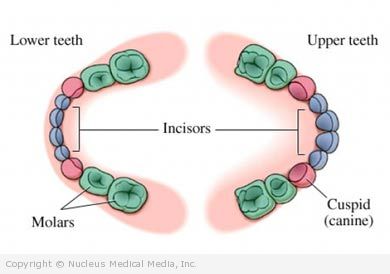(Cutting Teeth)
Teething – Definition
Teething is when a child’s first set of teeth breaks through the gums. It is a natural process but causes sore gums. Teething can make your child uncomfortable and cranky. Teething lasts from six months to three years.
Teething – Causes
The first teeth start to come in when the baby reaches about 6 to 12 months old. The first teeth are most often the two bottom front teeth. Other teeth will quickly follow. The pressure on the gums can make them swollen and tender.
Teething – Symptoms
Many babies do not experience any problems or pain. When symptoms do occur, they generally are present for several days before and a few days after the tooth comes through the gums.
Symptoms include:
- Drooling
- Wanting to chew on fingers or hard materials
- Rubbing the gums or ears
- Restlessness
- Irritability
- Increased sucking
- Reduced interest in solid foods
- Slight rise in body temperature
- Swollen gums
- Sensitive gums
- Rash on face (resulting from drooling)
If the baby is feverish and acts sick or very upset, seek medical care. Something else may be causing the symptoms.
Teething – Diagnosis
A doctor will diagnose teething by the baby’s age, symptoms, and appearance of the gums. A teething baby’s gums appear swollen and are tender. Sometimes small, white spots appear on the gums just before a tooth comes through. There may be some bruising or bleeding.
Teething – Treatment
Most children will only need basic comfort measures. Your doctor may recommend pain-numbing gels and medications but they are rarely needed.
Bring your child to a dentist when the first tooth comes in. Make sure to visit the dentist by one year of age. The dentist will perform an exam. You will be shown how to care for your child’s teeth.
Cleaning
- After each feeding, wash the baby’s gums with a soft, damp cloth or gauze.
- When teeth come in, brush them daily. Use a small, soft-bristled toothbrush or a damp gauze pad.
- If possible, use toothpaste without fluoride. If this is not available, use only a tiny amount of fluoride toothpaste. This will reduce the risk of the child swallowing it.
- Remove any drool. Keep the baby’s face clean and dry. This will prevent a rash.
Comfort Measures
Teething babies usually like to chew on a wet washcloth or teething ring. Guidelines for teething rings include:
- Make sure anything given to the baby is clean and too big to swallow.
- The teething ring should be made of firm rubber. It should be made of just one piece.
- Do not freeze a teething ring. It will become too hard, which could damage new teeth. In addition, the cold could hurt tissue in the mouth.
- Avoid teething rings with liquid inside. They could break open, exposing the baby to the contents.
- Do not tie a teething ring or anything else around the baby’s neck. If the ring or cord were to catch on something, the cord could choke the baby.
Other general tips include:
- Rub the gum with a clean finger or wet gauze to help reduce discomfort.
- Cool fluids may offer some relief.
- If crackers or teething biscuits are given, watch the baby carefully to prevent choking.
- Do not use alcohol.
Teething – Prevention
Teething is a normal part of child development.
To prevent other dental problems from developing:
- Do not allow the baby to nurse continuously.
- Do not nurse the baby to sleep.
- Do not give the baby a bottle with milk, formula, or juice when napping or going to bed.
- Between feedings or at nap time, give the baby a bottle of cold water to suck on.
- Keep the pacifier clean.
- Do not dip a pacifier in honey or sugar.
- Break the thumb-sucking habit by age four.
- Follow your dentist’s recommendations for brushing and using additional fluoride.

